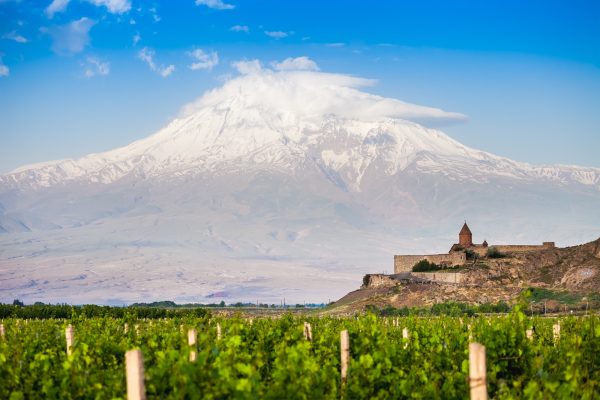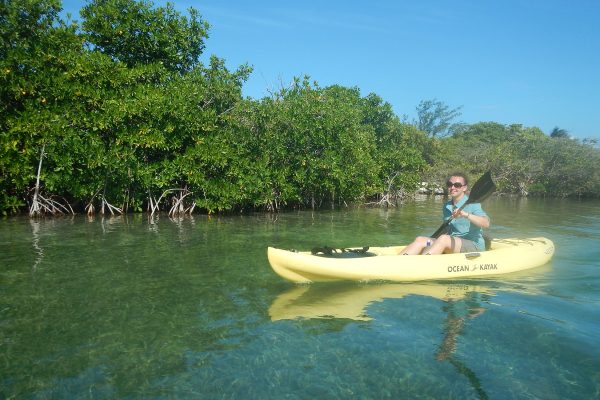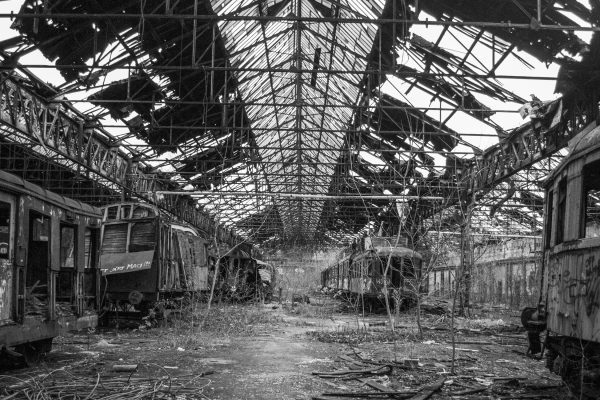Trip duration: 2 weeks | Approx cost: £900 | When: Spring – Summer
Doinit factor: You’re packing in a lot into a short time in this wonderful region.
The Balkans are still thought of by many travellers as Europe’s last wilderness. Others will think of Yugoslavia and more recently the wars and ethnic cleansing of the 1990’s. It’s true much darkness has befallen the region but it’s certainly not all doom and gloom as Marek Nusl found out on an intense two week trip crammed with as much as he could fit in.
The Balkans has an incredibly complex history, one which continues to heavily influence regional politics. Put the politics aside for a moment and you’ll be overwhelmed by the natural beauty, culinary delights and ancient old towns as well as a more modern history all combined in a sense of a travel wilderness. It’s hard to image you can see it all in a set time but two weeks can certainly give you an idea and definitely a thirst for more. My route through the Balkans was very much dictated by where I could use low cost airlines to arrive and depart. Low cost airlines are gradually expanding their service to these counties but still the network is quite sparse. In my case, I’d be arriving in Zadar, Croatia and 2 weeks later leaving from the Greek Island of Corfu. These are a reflection on my days.
Arriving in Zadar (and missing the only bus)
Day one
It seems Zadar is quite new to large scale tourism; in fact we’ve landed here on the first Ryanair flight of the year. The airport is pretty simple, yet we’ve still managed to miss the only bus transfer that day to the city. No matter, taxis are available and minutes after we collect our bags we’re being driven in to town.
Zadar old town is lovely. It is settled on a rectangular shaped peninsular. The streets are narrow and much of the area is pedestrianized making it great to walk round, stop of at a café and sip on some fine Croatian wine. Our stroll takes us past the church of St. Mary near the Roman Forum. Apparently there are 34 old churches within the peninsular but we don’t try to keep count. Instead it’s just nice to wander round and see where we end up. When we reach the sea front we come across a peculiar sound. It’s a Sea Organ. The motion of the water pushes air through an underground pipe network to produce notes, completely at the tempo of the movement of the sea.
Whilst Zadar is beautiful, it soon becomes apparent that there is not really much to do. We had planned to visit the world famous Plitvice Lakes but we’re informed that we’re out of season and transport networks don’t dare thinking about. Further discouragement comes that evening as its reported that the weather is about to turn wet, very wet. Reluctantly decide to forgo the chance for the lakes and instead head a day earlier then planed south and into Bosnia.
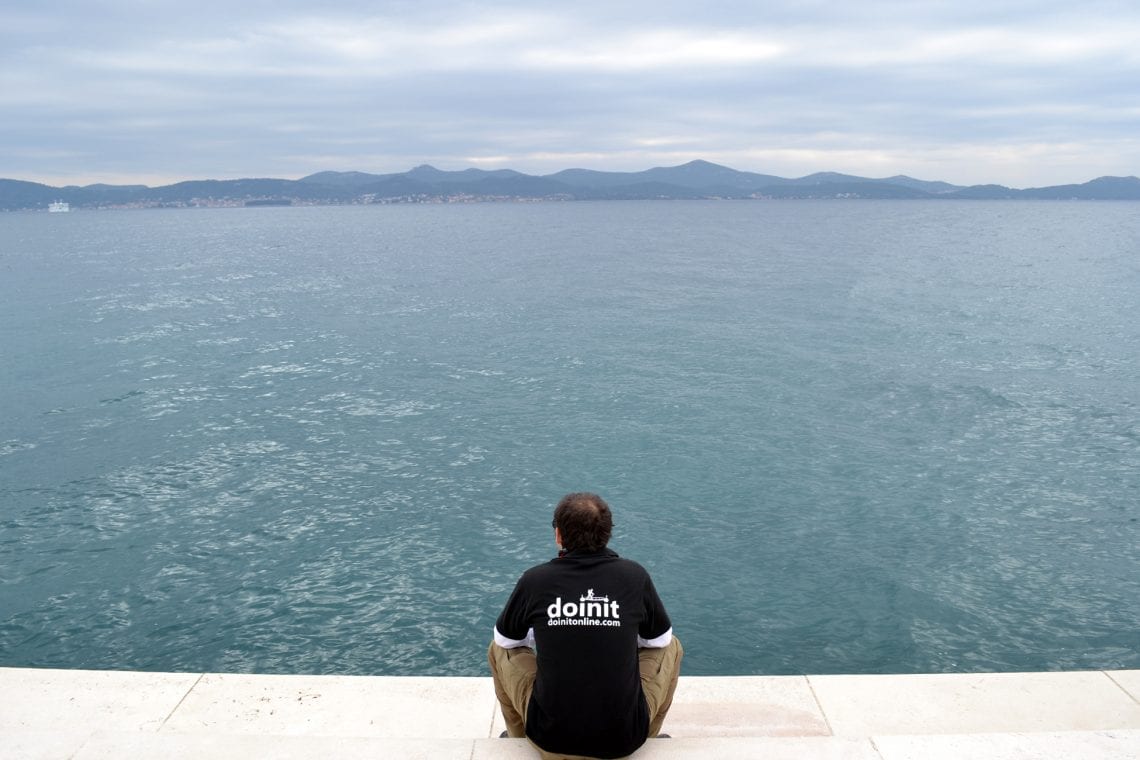
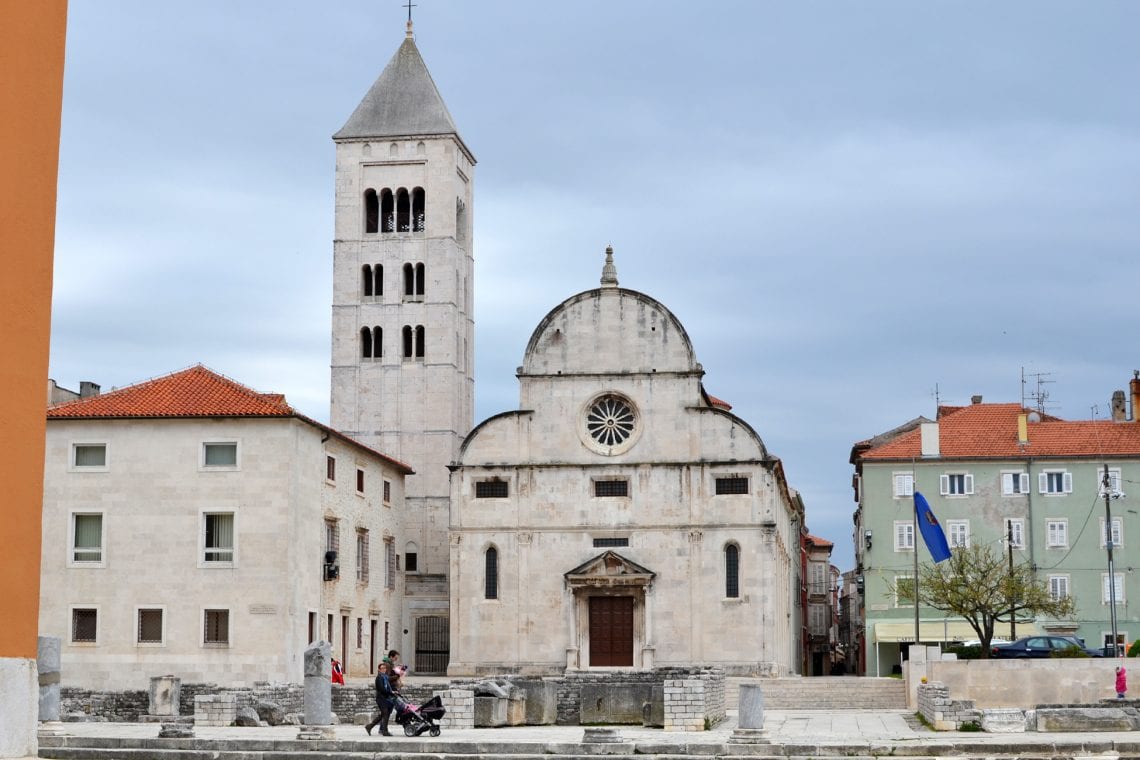
Above: Zadar is a very pleasant city, with no less than 34 churches concentrated within the old town
The Long Road to Mostar
Day two
It’s a long day on a coach from Zadar to Split, where we’ll be getting a on connecting bus To Mostar. The weather report did not lie as we witness some of the heaviest rain I think I’ve ever seen. The rain continues relentlessly so we’re confined to the bus station café as we wait 90 minutes for our connection to Mostar.
Only we board the 54 seat couch, and no one joins us at any of the other stops en route to Mostar. Over the 5 hour ride darkness falls and I can’t help but have a slightly uneasy feeling as we head into Bosnia; why aren’t there any other passengers? This uneasy feeling was of course completely unjustified and we arrive at around 10pm at Mostar bus station, which is deserted. Fortunately our host for the evening arrive shortly to take us to our beds for the night.
Magnificent Mostar to Surprising in Sarajevo
Day three
Mostar is famous for its old stone bridge, it’s the symbol of this city and of course it’s what we’ve come to see. It’s a cold miserable morning, but that ensures a brisk pace is kept as we walk along the river side and the deserted cobbled streets of old Mostar. During the Balkans wars Mostar was on the front line and there is plenty to remind a visitor of this as abounded and semi destroyed buildings remain dotted around the city. The famous bridge was also a casualty of the conflict but has since been restored. During the summer months the Mostar diving club jump from this tall span into the near freezing waters below attracting hordes of spectators , but today it’s pretty much deserted.
The views along the bridge are somewhat eerie today as low cloud engulfs the many minarets along the valley. It’s mid-day before we head back to the bus garage for our journey up to Sarajevo. Compared to the other days coach journey it’s a mere two and a half hour trip to the capital of Bosnia Herzigovina. The road meanders through the valleys, tunnels frequently penetrate the rocky walls and bridges take you over fast flowing rivers below. It’s a stunning albeit precarious drive.
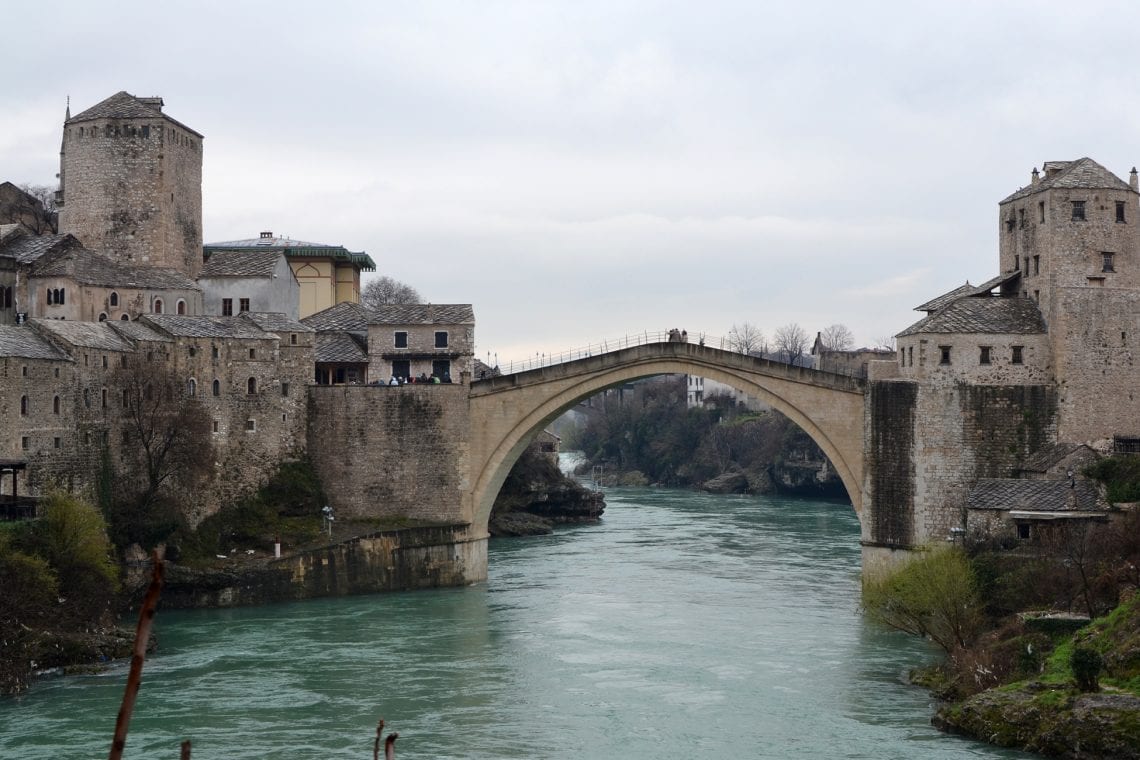
Above: The famous bridge in Mostar, divers regularly will dive into the freezing waters below
We arrive in snowy Sarajevo (yes it’s April). We drop our backpacks of at our hostel and venture out to the old town to explore. Sarajevo has played a very significant part in history; on the 28 June 1914 Archduke Franz Ferdinand of Austria was assassinated on the Latin Bridge setting in motion the events leading up to the first world war. It’s an incredibly sombre moment as we find the wall carved with a memorial to where the assign took his fatal shot almost a century ago. We cross the bridge and then a back again trying to absorb the sheer significance of this place as passers by simply go about their day to day business.
The city is a mix of socialist, Austro-Hungarian, and Ottoman Architecture. The old town is home to small craft shops, mosques and hip bars. Sarajevo is set within a valley which gives this city its longitudinal shape. As it gets dark we jump on the tram. The tram network runs a counter clockwise route within the city so there’s no worry about getting lost as at some point we’ll end up back were we got on. It’s a great way to see the city as we zooming past the surrounding congestion. After dinner consisting of meat stuffed vegetables (yum) it is time to hang out in one of the many hip trendy bars which have sprung up in the city.

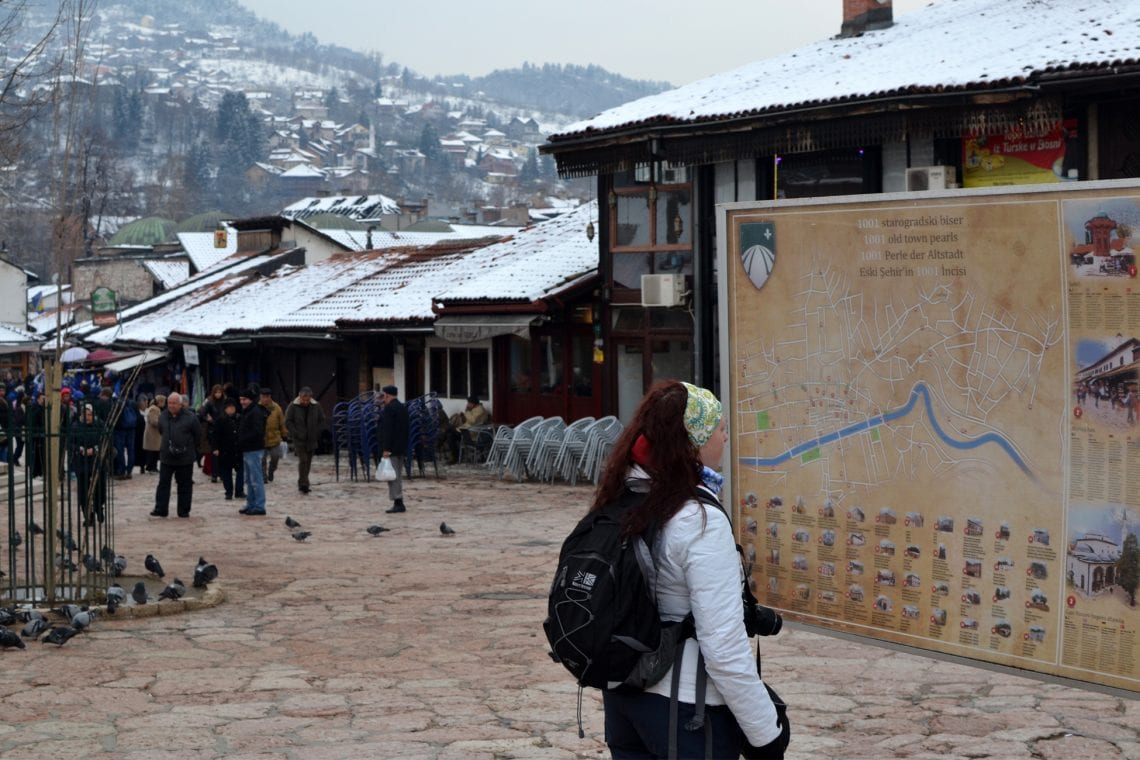
Above: The ‘Latin Bridge’ were Archduke Franz Ferdinand was assassinated | A monument marks where the shots that killed Archduke Franz Ferdinand were fired from | Emma in the old Bascarsija Square
Double Back to Dubrovnik
Day four
We awake in the morning to find it snowing heavily, I’m a bit worried, back home even the slightest flurry would mean all transport links come to an standstill but here its business as normal. I’m sorry to be leaving Sarajevo so soon and I know we’ve missed out on a lot but just a few hours in the city has given me a craving to return. Today we’re boarding another coach. It will take us back along the same route we drove yesterday, back through Mostar before taking a turn south. It gives us a chance to appreciate the wonderful scenery. It’s about 6 hours before we’re on the coast, far away from the snowy morning. Now it’s 20something degrees, with not a cloud in the sky as the sun’s rays reflect from the ocean below our windy coastal road.
We arrive in Dubrovnik, and again we’ve chosen to accommodate ourselves within the old town. The marble streets and white walled buildings are fantastic to walk around, it’s like being back in time. We lose ourselves within the secluded old harbour where we discover an amazing seafood restaurant. It’s the first time we’ve had nice weather on our trip so we’re happy to relax in such an atmospheric place. It’s also the first time on our trip we’ve seen masses of tourists, but that’s to be expected in Dubrovnik as it’s well know as a tourist trap. While Dubrovnik’s undoubtedly a stunning city, like Zadar I wonder how much time can you really spend here before you run out of things to see or do?
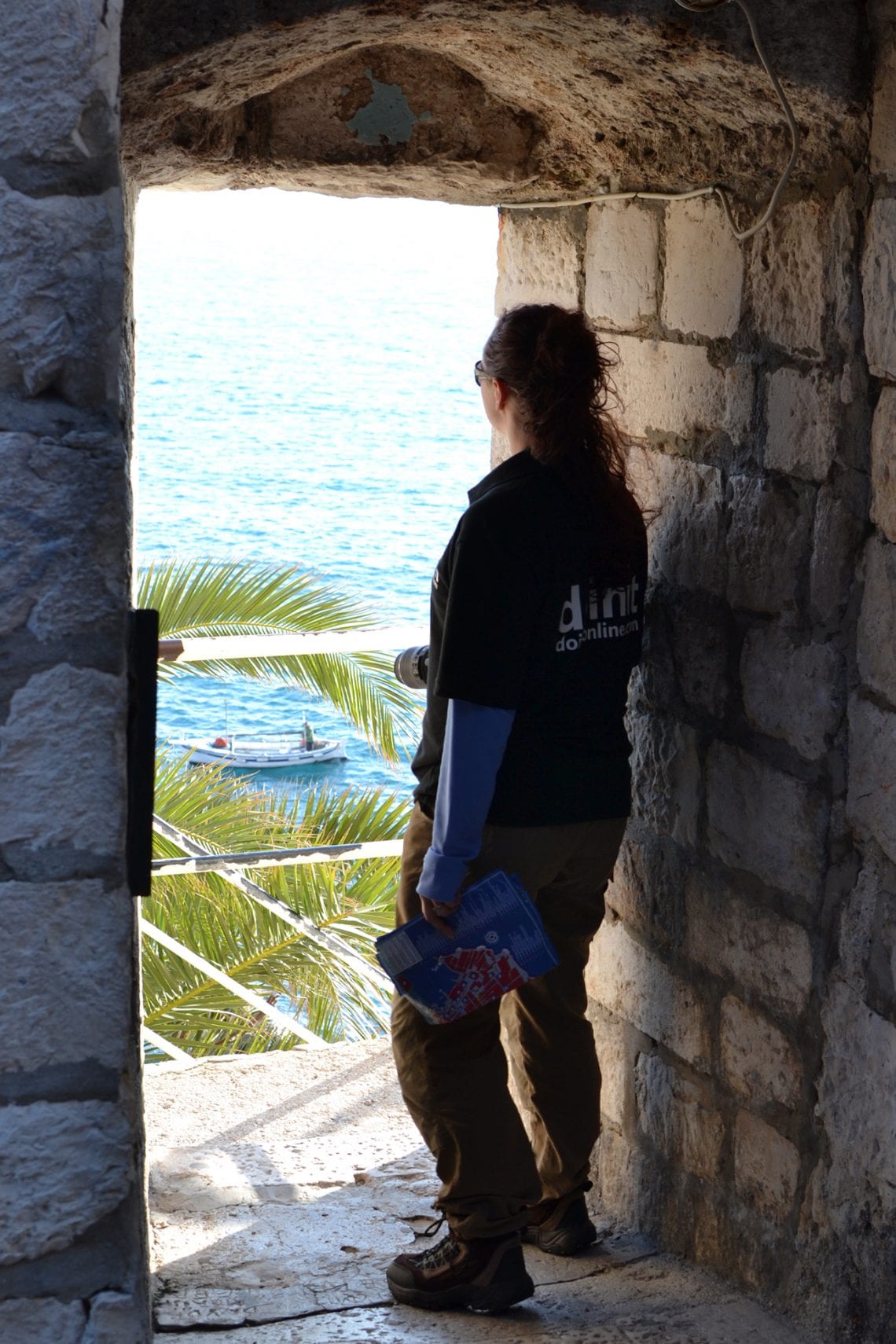
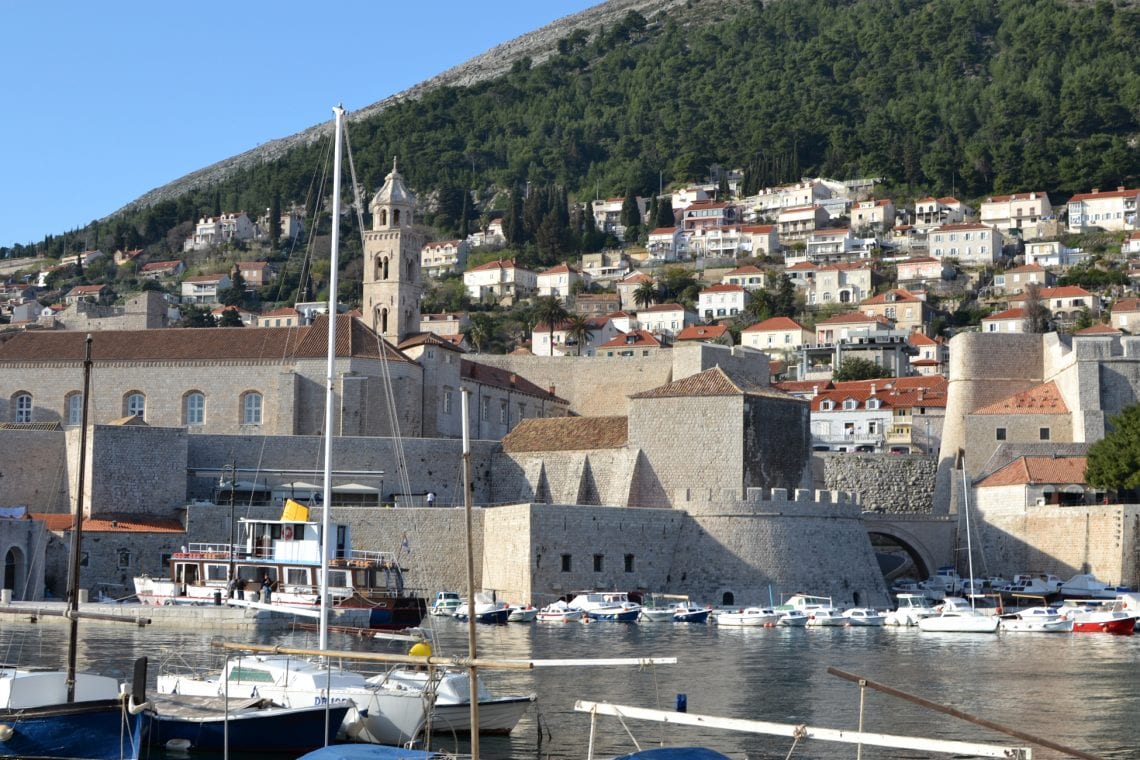
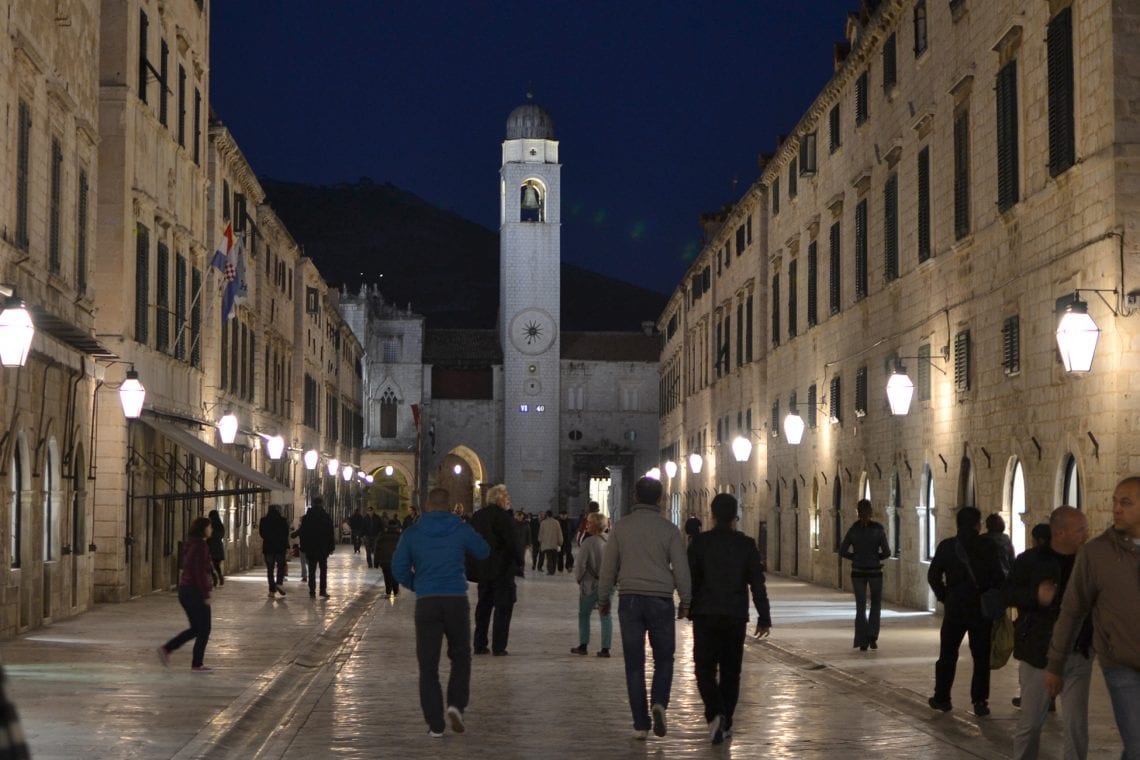
Above: A day in beautiful Dubrovnik
Dubrovnik to Budva
Day five
We’re bound for Montenegro and the town of Budva where we’ll be staying for a few days. Again the coach takes us through some stunning scenery. En route the Kotor Bay is mind-blowingly stunning. It’s sometimes referred to (incorrectly) as Europe’s southernmost fjord. Huge mountains line the bay and tower above the quaint settlements en route. Our destination is Budva, Montenegro’s premier resort. Its old town is a mini version of Dubrovnik, perhaps more rough around the edges but that’s part of its charm. During spring there’s hardly any tourists here and we’re easily spotted as we wander, lost within the labyrinth of narrow lanes. “Hello, are you looking for Hostel?”
Once we’ve unloaded our backpacks in our hostel we’ve hours to walk the city walls overlooking millionaire’s yachts moored just outside the city walls. The sun falls behind the surrounding mountains and the lights of this city reflect across the bay.
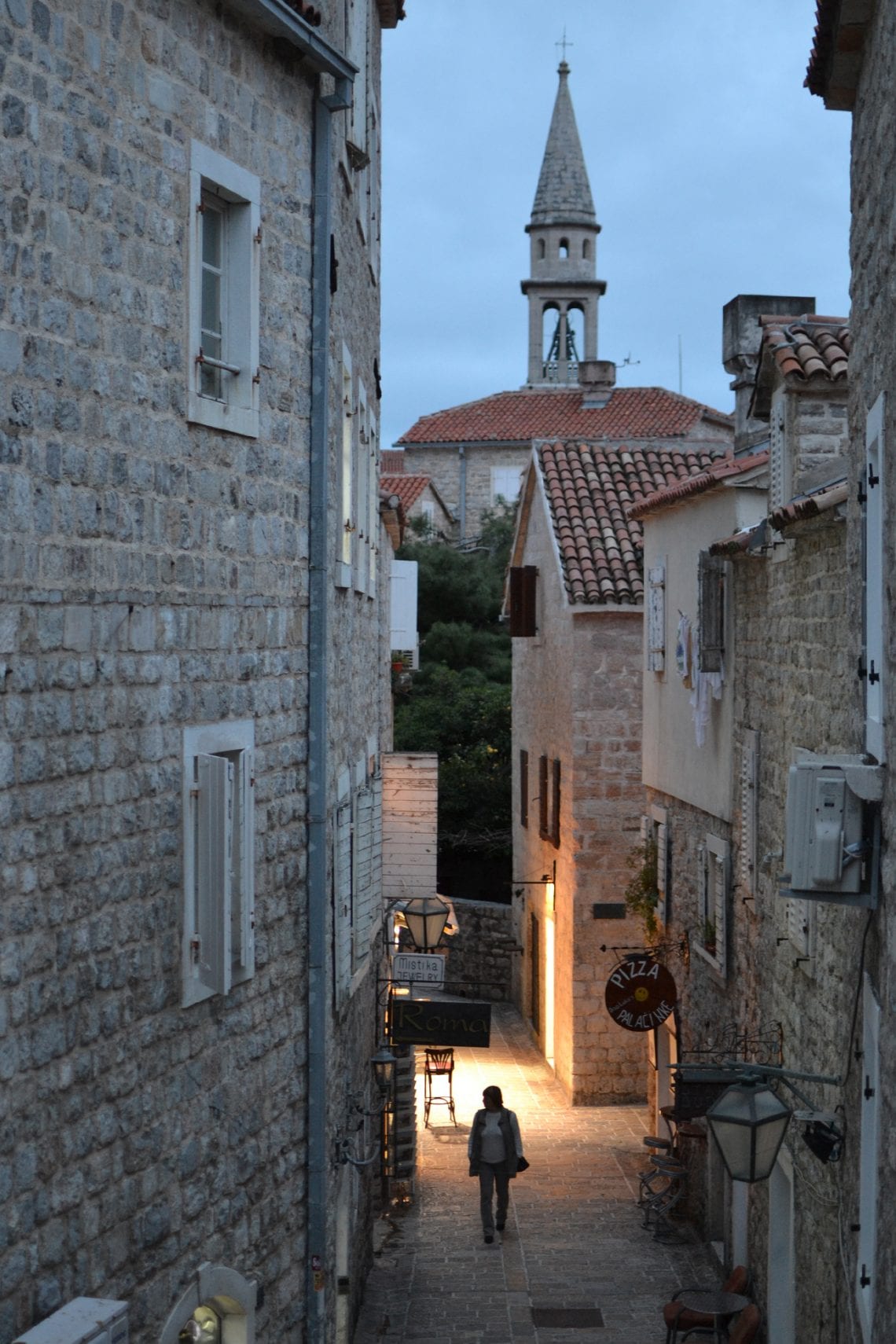


Above: Exploring the medieval old town of Budva
Big Montenegro Tour
Day six
Our hostel has arranged a “Big Montenegro Tour”. It’s a full day’s excursion over this small country. We’re picked up by Mladen, our guide for the day. Within minutes you can tell that he loves his country, he’s eager to tell us all there is to know about his country. First stop is breakfast, then we drive high above Kotor Bay, high enough to become engulfed in cloud as we continue to climb. We arrive at a lonesome smoke house; it is here where we treated to a traditional Montenegro breakfast. Ham and cheese sandwich, but the traditional part is what follows…a large shot of locally produced rakia. The rakia is washed down by equally as strong coffee, it’s like syrup. I’m certainly awake now. After breakfast we’re shown the smoking process. The ham and cheese we ate a few moments earlier are actually made in this building.
Our tour continues along the side of huge mountains and gorges towards the Ostog Monastery. A bit like Petra this 17th century place of worship has been carved into the cliffs, we make our way up the many steps and are allowed to enter to pay our respects. This is one of the most visited monastery’s in the world and is important to Orthodox, Catholics and Muslims. Despite the crowds we experience a few tranquil moments as we take in the views across the flat plains below.
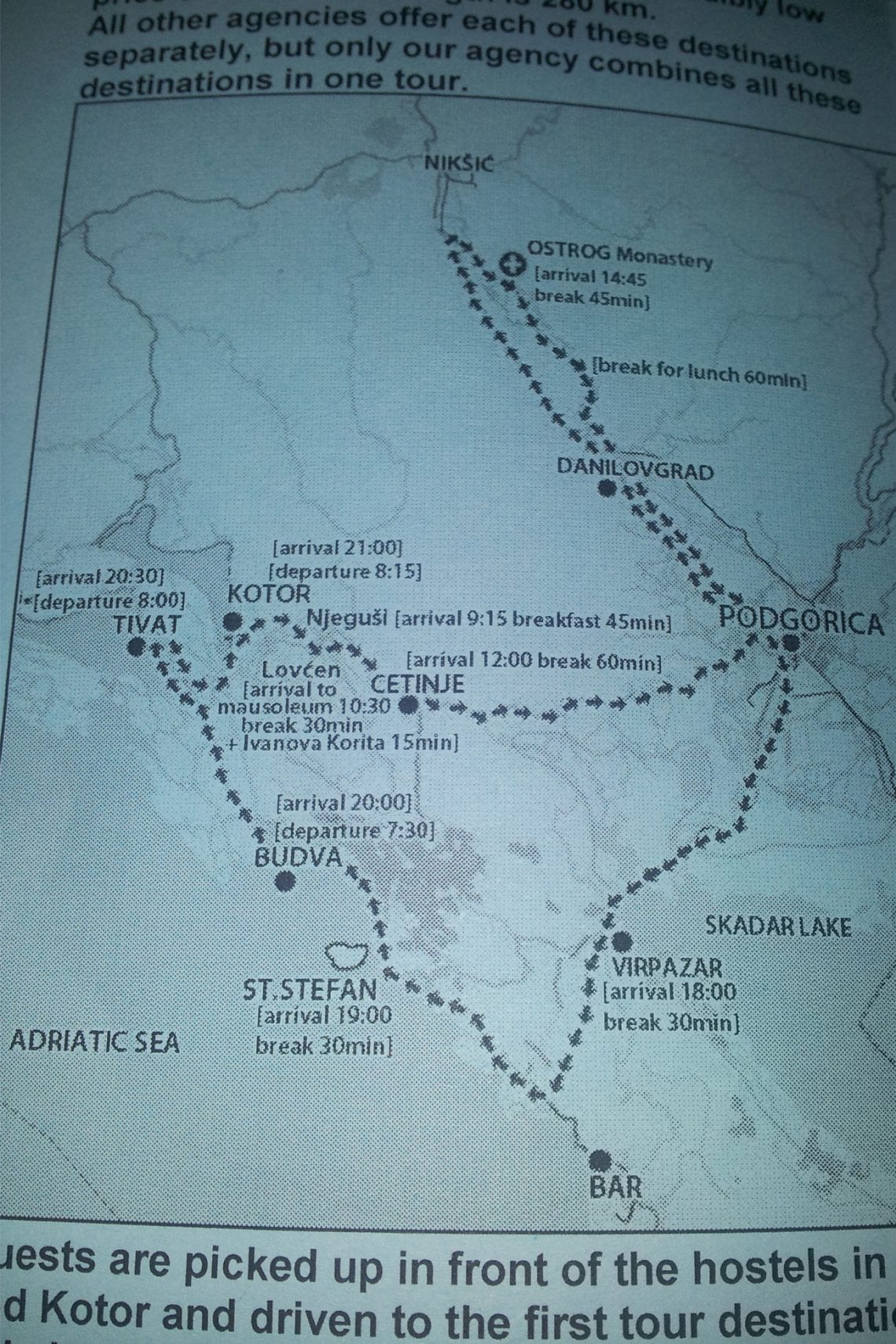
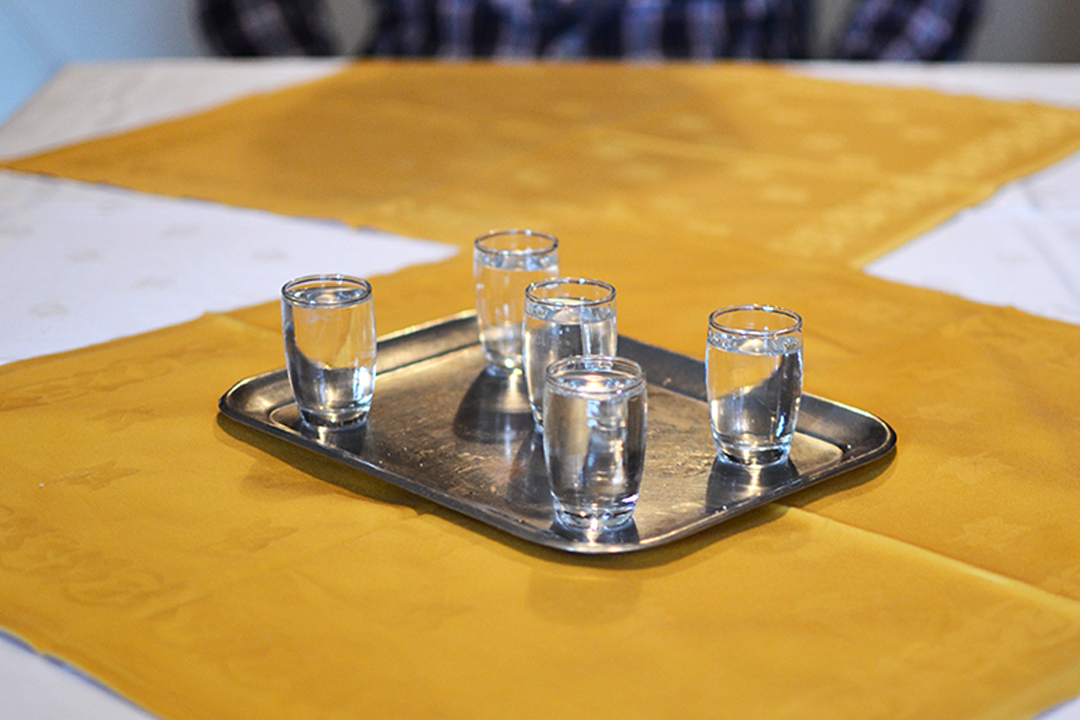
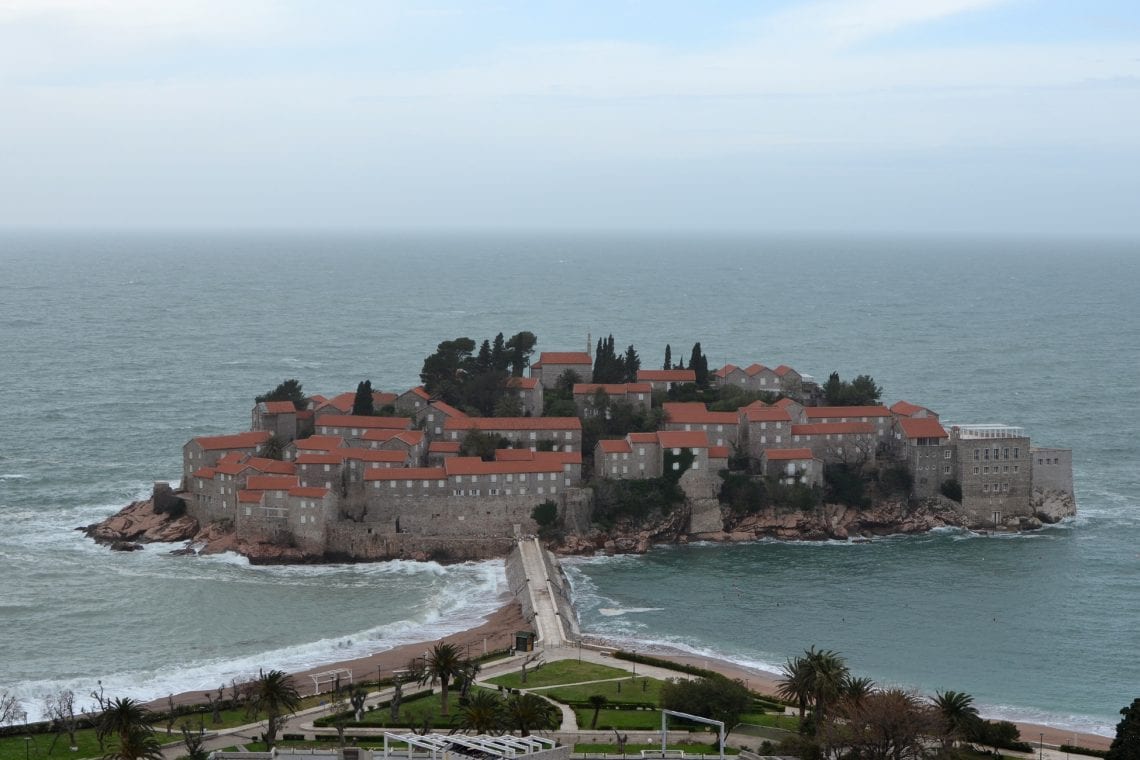
Above: A few highlights from ‘The Big Montenegro Tour’ are Ostog Monastery, River Crnojevic, Sveti Stefan, oh and rakia for breakfast
We make regular stops on route to lunch or areas of outstanding beauty for lots of pictures. Montenegro may be home to some of Europe’s most amazing roads, but they’re not in great condition. Unfortunately due to the adverse weather that’s been hitting the region lately there are a few sights which are inaccessible, but nevertheless it’s an enjoyable day. We continue on through the old capital of Niksic before we have a late lunch in Potgarica. Mixed grills are all round a Balkans favourite. Surprisingly Montenegro’s capital is somewhat subdued, with very little of the original city still standing, namely the Ottoman clock tower remains of the original city.
Our tour concludes with a visit to Skadar Lake, the Balkans largest, and it’s very picturesque as the sun begins to set. It’s dark by the time we’re on board our minivan and we pass Sveti Stefan a small islet, pictured in all travel guides, an image that is synonymous with a visit to Montenegro. However this is a private resort and most visitors will only see this place from a distance.The tour’s been a great way to see a large part of this country in a relatively short amount of time.

Above: The Millennium Bridge and town clock tower in Podgorica
Book this tour
Mladen is an enthusiastic and knowledgeable tour guide. He provided us with a great tour of the country and helped us with transfers. He is happy to recommend things to see and do, as he is happy to create a bespoke itinerary for you. If you’r in the area it’s well woth enlisting his services. www.mtours.me |
Onward to Albania
Day seven
Mind bogglingly the transport links between Albania and Montenegro are a bit sketchy at best despite the relatively short distances. Again we’ve called upon the services of Mladen who’s agreed to drive us to Tirana. Straight away Albania is very different to the rest of the Balkan countiesr, the language is very different, the infrastructure seems less developedand there are many unfinished construction sites with no sign of a work force. Albania seems to be full of Mercedes, potholes and carwashes. We make a final stop off at Skodra Castle, high up on the hill overlooking Albania’s second city below. It’s nice to get out the van and stretch our legs.
It’s a few more hours and a bumpy ride before we finally arrive in Tirana. It’s busy, crowded, and somewhat chaotic. Car horns blast from all directions, gypsy children approach you can grab you hand as you walk on the street as if asking to be taken away, touts bid for your attention and beggars reach for handouts. Grey, socialist, concrete blocks dominates the skyline. Our hostel provides a means of escape from it all and allows us to readjust to our new surroundings.
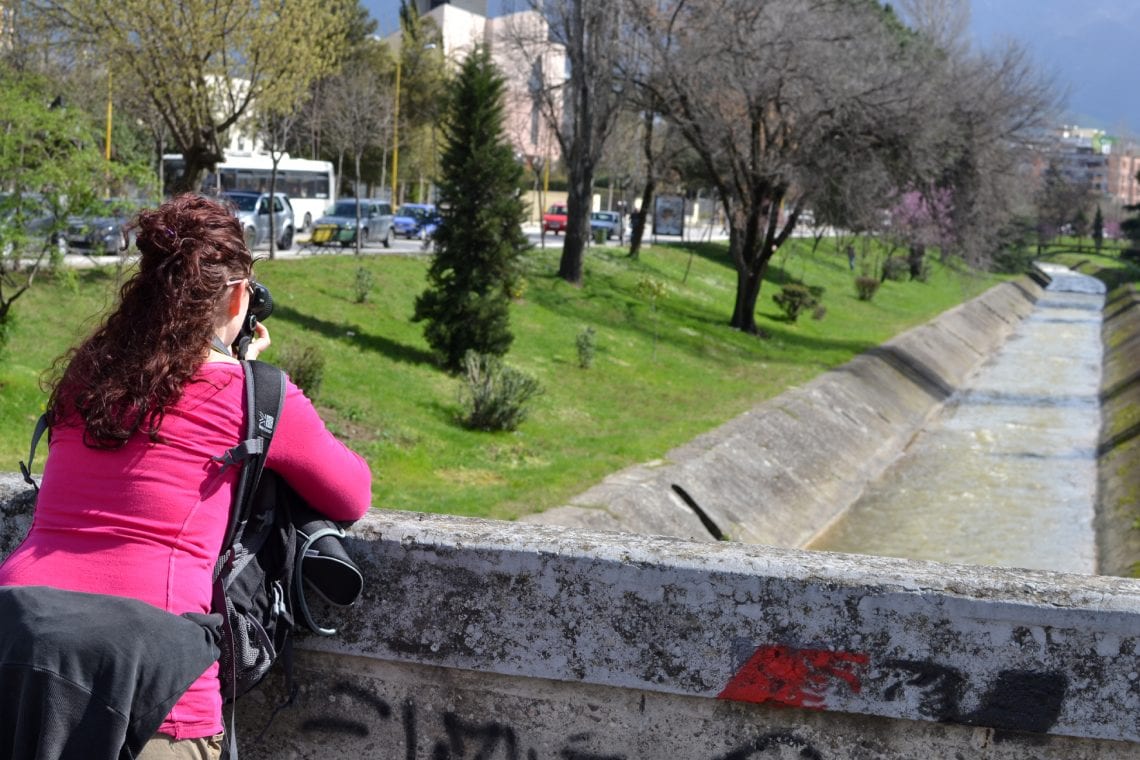
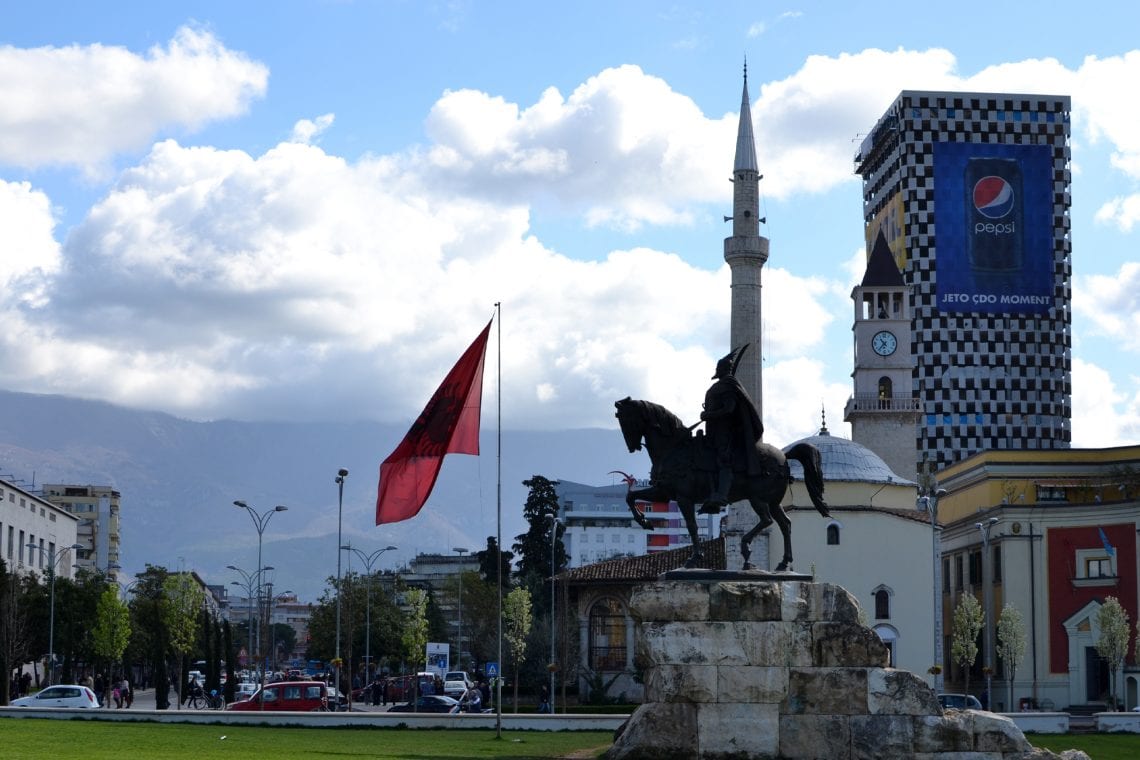
Above: The Tirana Pyramid is a former museum, now it stands abandoned in the middle of the city | The river Lana running through Tirana | Skanderbeg Square
Dazed and Confused in Tirana
Day eight
The morning allows Tirana a second chance to woo us with its… uniqueness as we take a walk around the central district. We’ve read that the city is experiencing a revival but perhaps we’re just too early. Soon we’ve got our backpacks on and heading towards the part of the city where we’re told we can pick up a minibus to take us to the Macedonian border. Transport in Albania is interesting. For a start the city doesn’t have any bus stops, instead minibuses called Furgon pickup from “areas” i.e. near the old school, around the US Embassy, etc. A bit perplexed by this system I’m doubtful if we’ll get anywhere but then out a blue one of these Furgons drives by slowly with the driver shouting out the window “Podgradec”. Amazingly that’s our ride, a town close to the Macedonia border on Lake Orhid.
The driver races through mountainside as if he’s practicing for the formula 1. Up and down sharp hairpin bends, until we’re forced to pull over. One of our fellow passengers can’t hold it in any longer as she runs behind our furgon to be sick. Emma looks at me as if to say it was almost me. Lake Orhid comes on to our horizon, massive and surrounded by mountains, it’s the opposite shore we’re hoping to reach. We’re dropped at the border and make our way to customs. There are a few cars before us as we stand behind with our backpacks on the road waiting for our turn at the drive through customs post. It’s pretty straight forward, our passports get stamped and we’re free to carry on. There’s no town or any connection so we’re to walk to the next village or hopefully hitch a ride along the way. After an hour or so we’re lucky enough to wave down taxi and jump in with a local couple who are heading to the city of Orhid.
Orhid, which takes its name from the huge lake, has a rich history that has made it an UNESCO heritage site. The fortress stands proudly on the hill and the city is dotted with Byzantine churches and monasteries. An archaeological showcase displays new discovers and there are a large number of integrally placed mosaics on display. The town has a real laidback feel about it, the smell of grilled meats wafts along the main promenade. Again we’ve arrived before the main season and it’s still peaceful. I don’t know if it’s because of the chaos from Albania, but we instantly fall in love with this town and decide to stay an extra day.


Above: Crossing the the boarder from Albania to Macedonia | Waiting for a bus to take us to Ohrid
Getting Drenched in Orhid
Day nine
The weather is not good, heavy rain falls relentlessly. It’s time for our waterproofs as we head to visit the castle which overlooks the lake. Fortunately when we’re on the fortress walls there is a brief let up in the rain, but not for long. There’s a path which leads to a forested area where we able to find some shelter and as we follow the path we come across a lovely little the ancient church St.John Kaneo. Even in this weather there are some fantastic sights as the lake and mountains make a picturesque scene. We snap what pictures we can before running along the lake to take shelter in a nearby town in a warm restaurant. After a day of getting drenched it’s time to relax in the cafes and sample the Macedonian specialities like Ćevapi washed down with a bottle of Skojska.
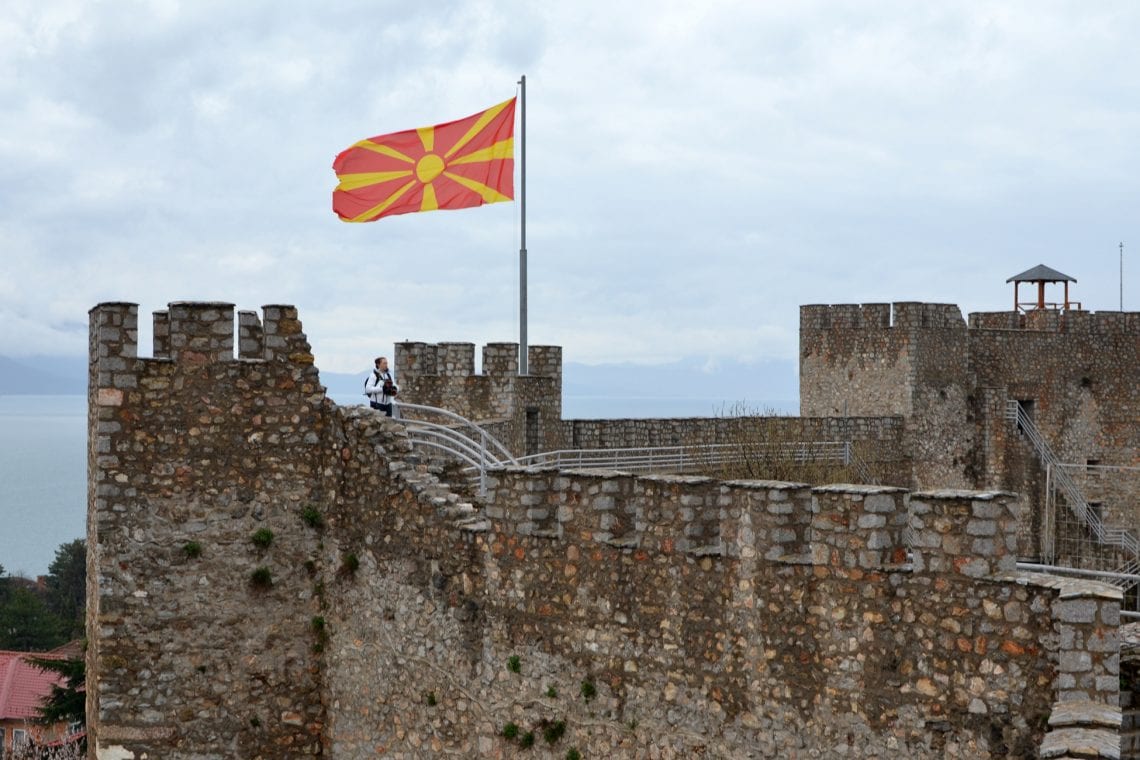
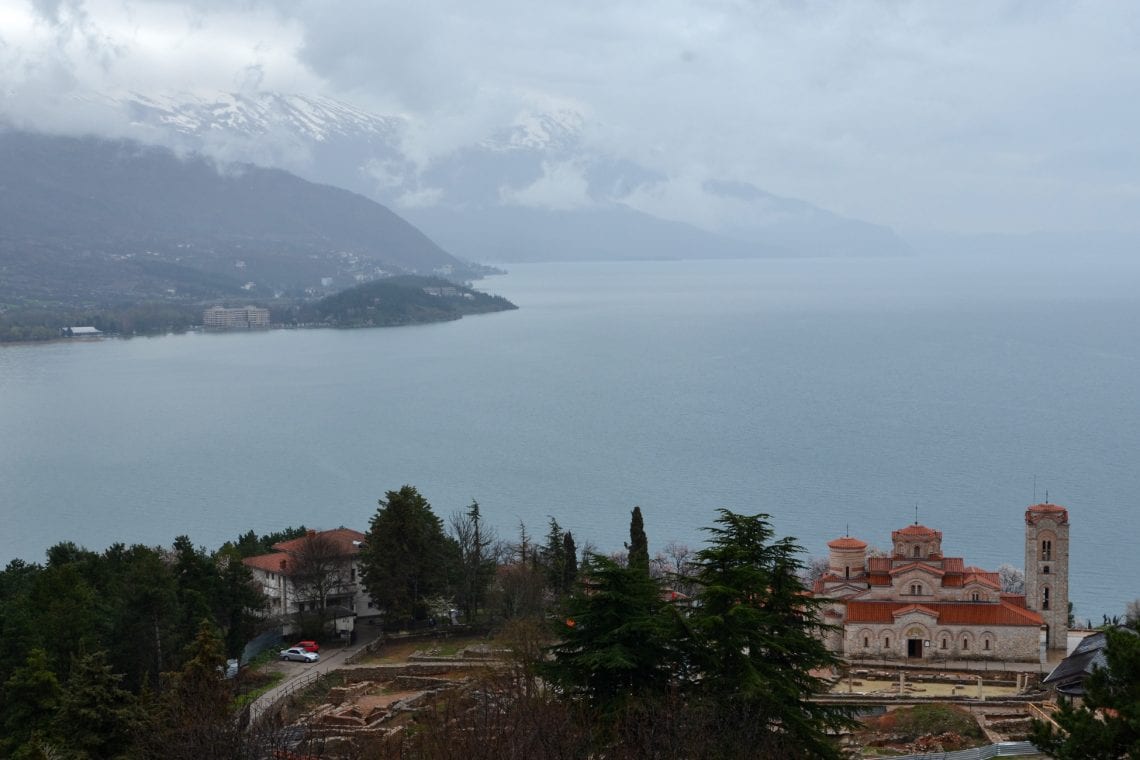
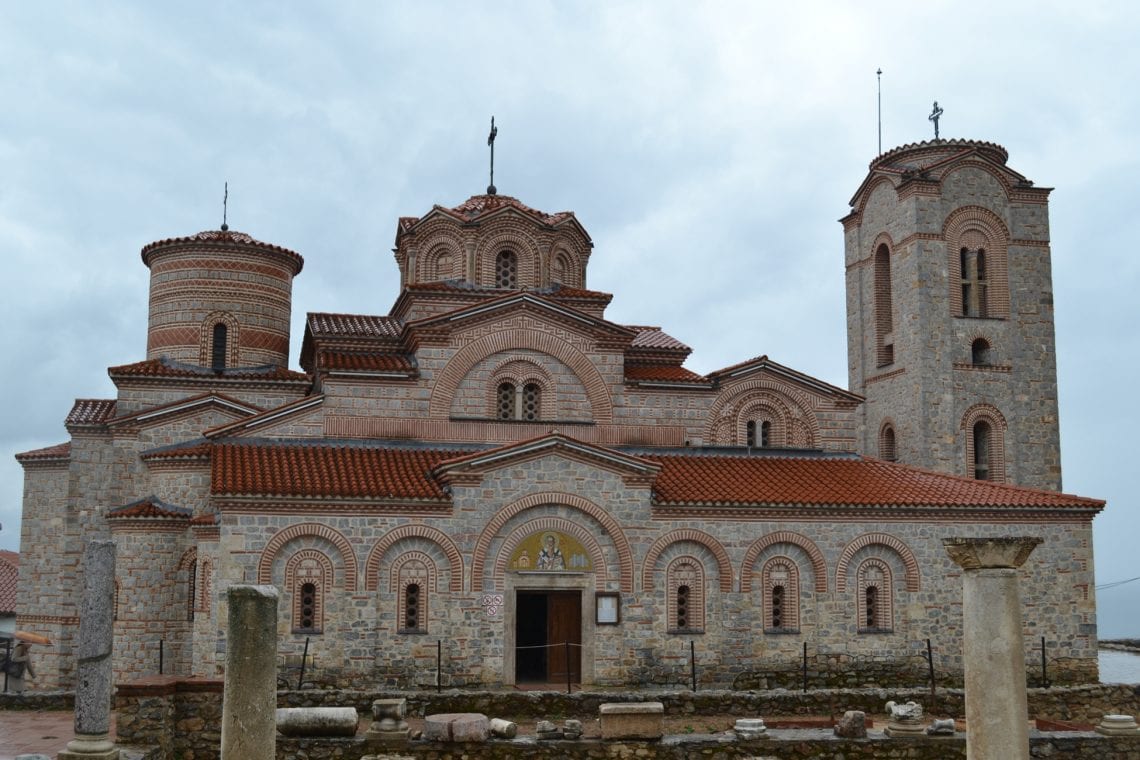
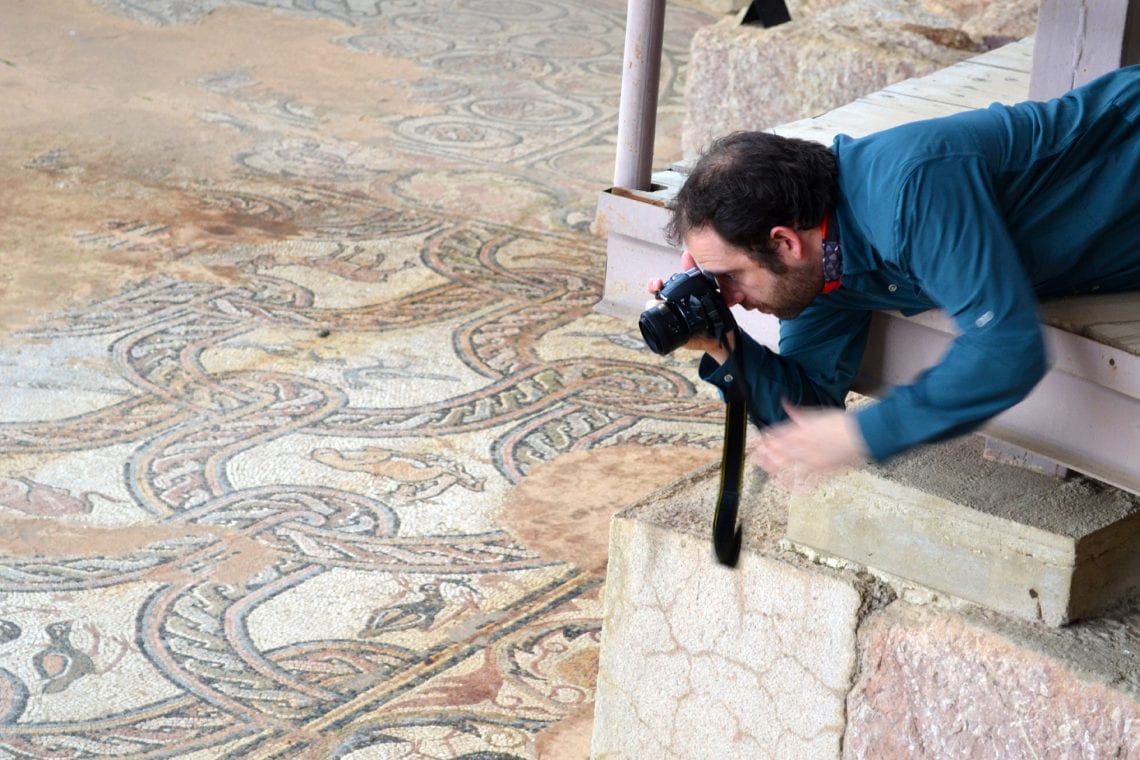
Above: Exploring the castle and monasteries in Ohrid on a a very wet and gloomy day
The Final Bus Journey and Back to Albania
Day 10
It’s early morning as we share a taxi with a local man to the neighbouring town of Struga; here we’ll be catching a bus back to Tirana. Funnily enough as we board the bus we bump into a familiar face a fellow traveller we met back in Macadamia, it’s really a small world!
Back in Tirana, we’re on the lookout for a bus which will take us south to Sarande a popular beach resort in the south of the country. Again the plan is to rock up in the right district in the hope somehow our ride will find us, but which district? Time to resort to a foolproof plan- get a taxi and repeat “Sarande , Sarande Sarande” until he understands that we want to go to wherever we can get a bus to Sarande. It works. Apparently taxi drivers are somehow informed, despite the lack of bus stops and time tables they know exactly what’s running where.
The bus journey is long, hot, slow and the road conditions are terrible. The road, and bear in mind this main road is a dirt track in places, is almost washed away in places. It’s impossible to get conformable let alone get any sleep. Again a common theme with the Balkans is that drivers seem fearless as they drive through tight corners where once can be sure many have gone off in the past. I’m relieved when darkness falls, at least I won’t be able to see the end coming. We arrive in Sarande at about 10pm, It’s taken over 12hours from Orhid and we’re knackered. Our hosts aren’t obvious to find as they’re located on the 7th storey of a block of flats. We’re welcomed by Gabriel and Mica with a cold beerand I know I’m going to enjoy the last few days of our trip in this place.

Above: We finally made it to the top of North Africa | A trig point marks the official peak
Sunny Sarande
Day 11
The next morning we catch-up with our hosts and they suggest a few nearby places worth visiting. It’s a lovely sunny day. We walk along the beach and in the distance we can see the Greek island of Corfu where we’ll be heading in a few days. We make our way to the nearby castle which overlooks the city for some incredible views; it’s about an hour’s walk uphill before we make it to Lëkurësi Castle. That evening we introduce the game of cheat to our hosts were we play long into the night accompanied by some Albania Rakia.
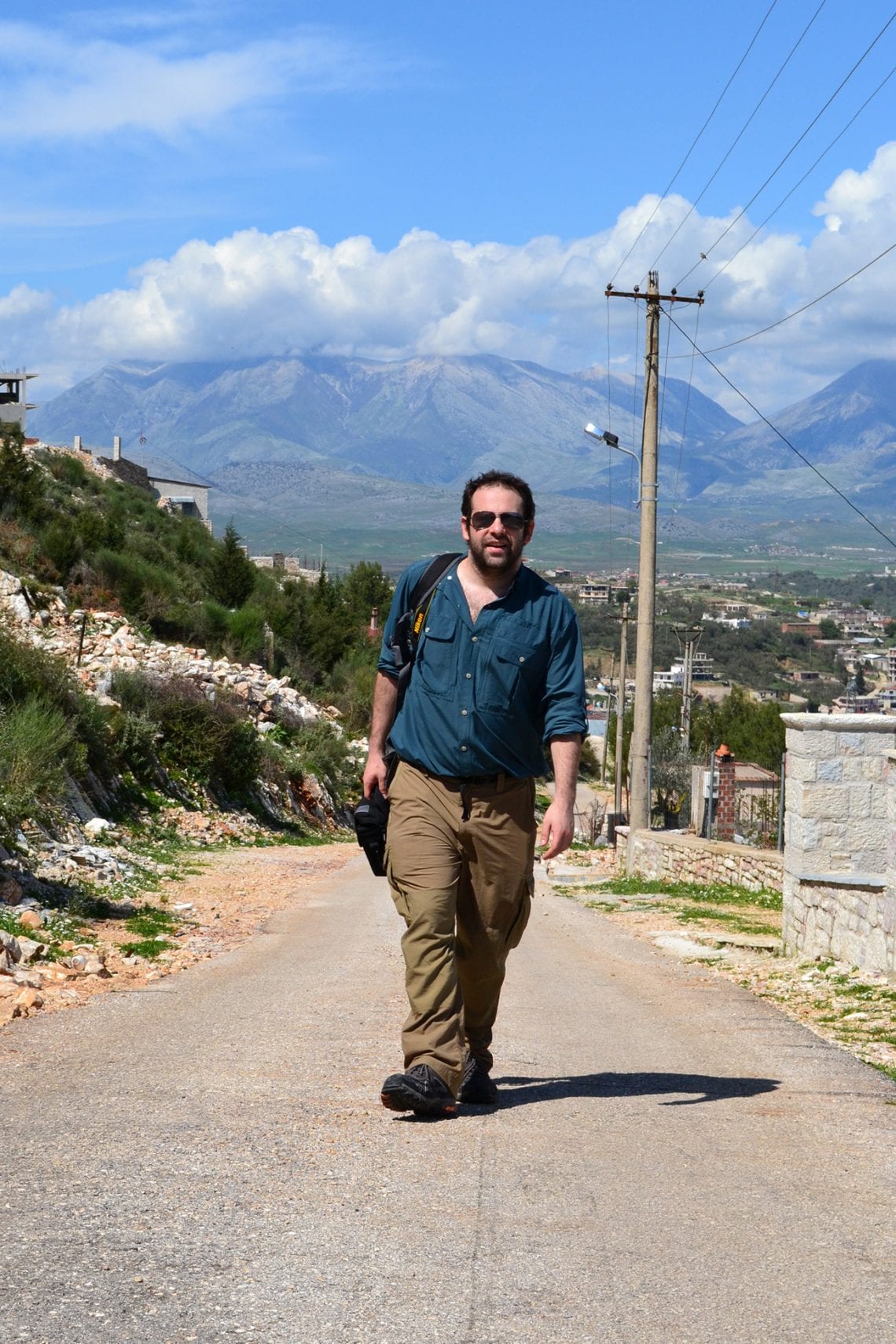
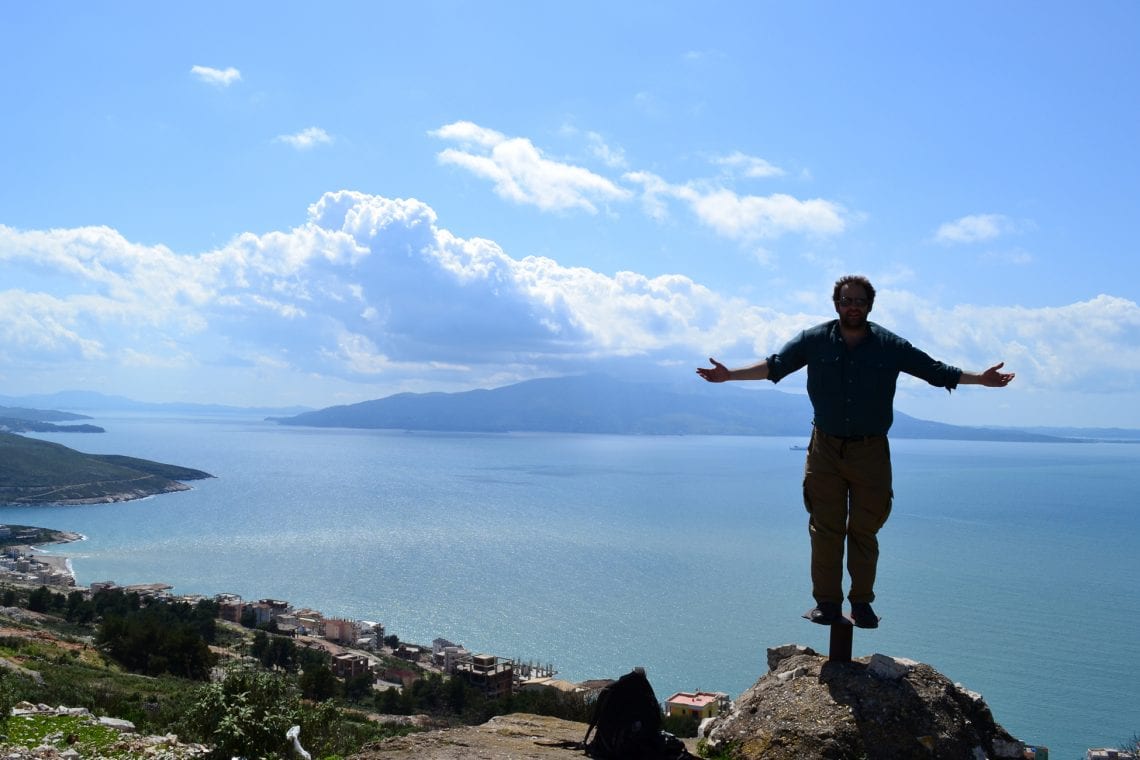
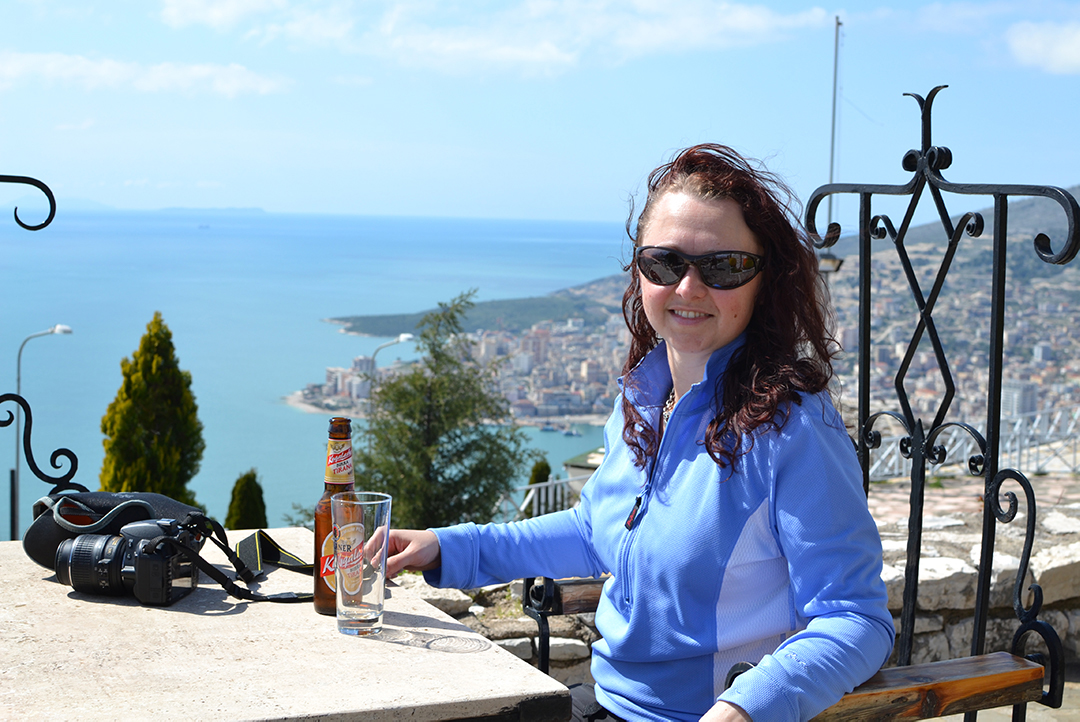
Above: After a long walk up to Lëkurësi Castle it’s time for a beer and take in the views
Exploring Batrint
Day 12
We’ve been told of an the ancient city of Batrint nearby, a UNESCO World Heritage site which is a massive archaeological park where one is free to wander around the ruins. Parts of the city are flooded but if you look closely you can see terrapins basking on rocks. The 4th century was the height of this cities glory, it formed part of the Greek empire and later fell to Rome. Once the city had gymnasiums, baths, amphitheatres and aqueducts but now it’s overgrown with vegetation. It was considered an endangered site up until a few years ago but recent conservation work has paid off. It seems we’ve the entire site to ourselves, I guess that’s one of the advantages of visiting out of the normal tourist season.
The rest of the afternoon is spent relaxing by the coast, enjoying the traditional fast food of choice, Suflect (grilled meat with chips in a wrap). It seems down here Albannia is certainly making up for its lack of charm earlier. We spend our last night catching up with our hosts, they really made us feel welcome and without a doubt they’ve made our stay a fantastic end to an awesome trip.
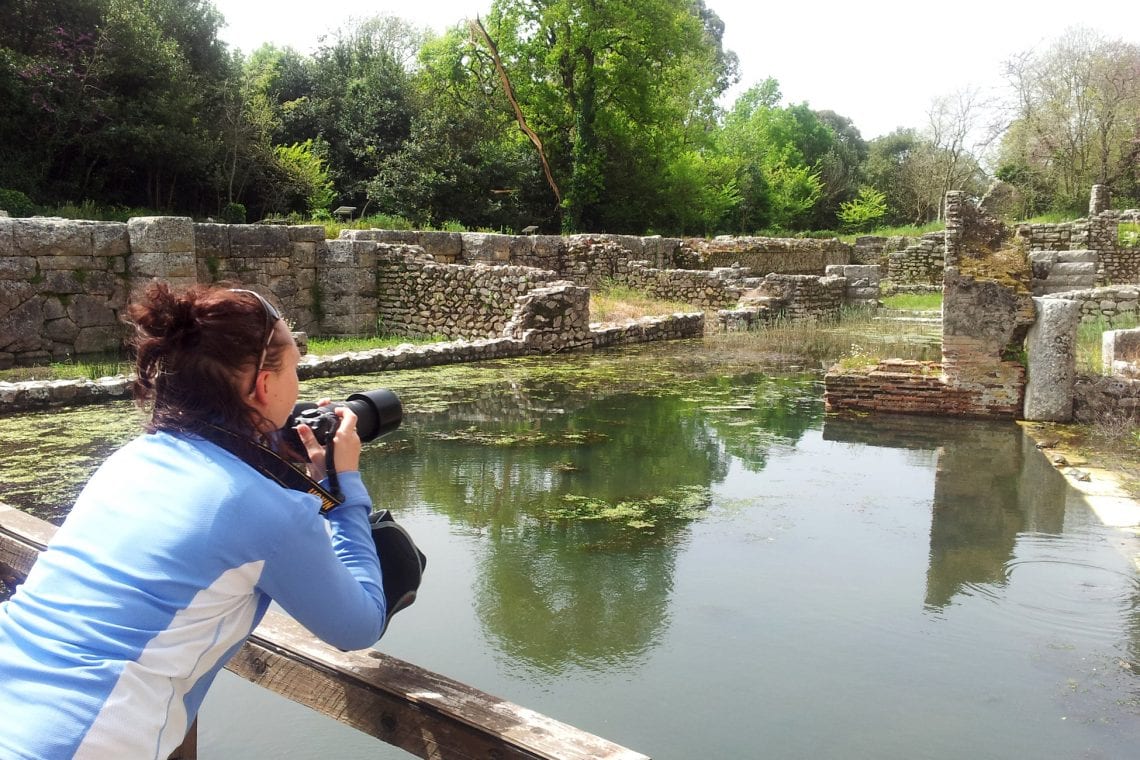


Above: Exploring the ruins of Butrint
Goodbye and Farewell
Day 13
Our quick tour of the Balkans is come to an end. Currently no budget flights leave Albania for the UK so we’re boarding the afternoon hydro-foil to the Greek island of Corfu where low cost airlines are well established. It’s from here that we’ll board our flight back home to the UK, but not before my first dip in the Adriatic sea on this trip.
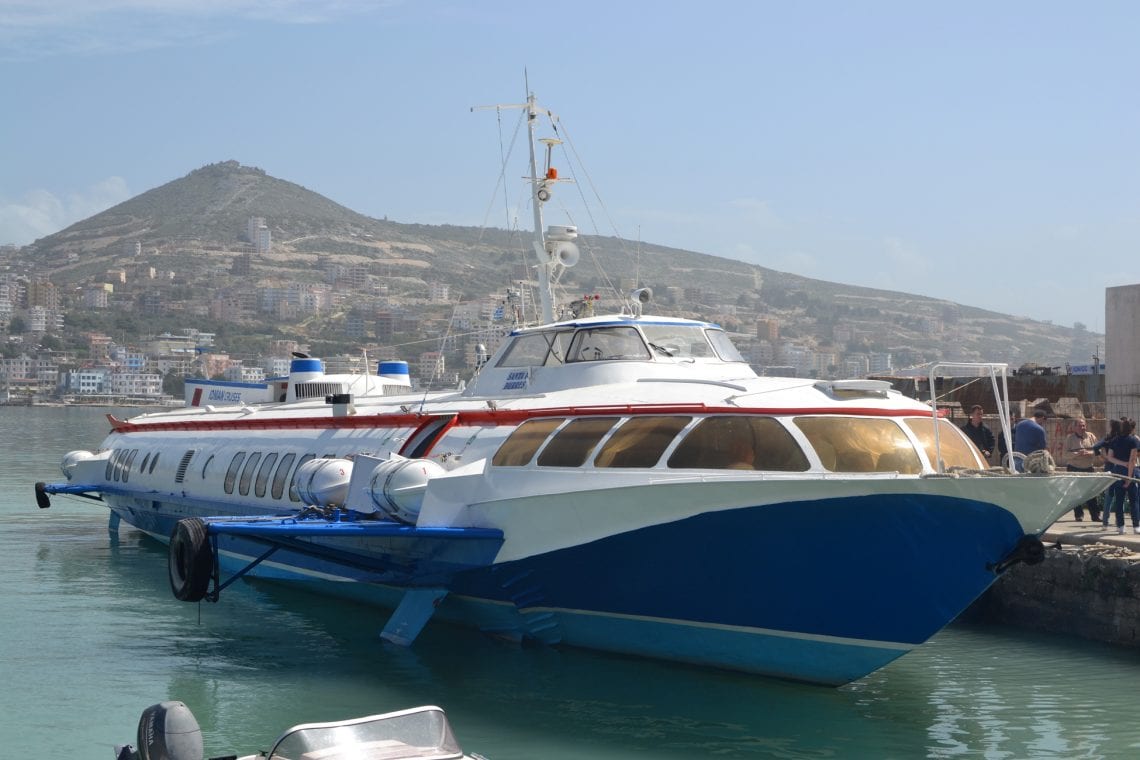
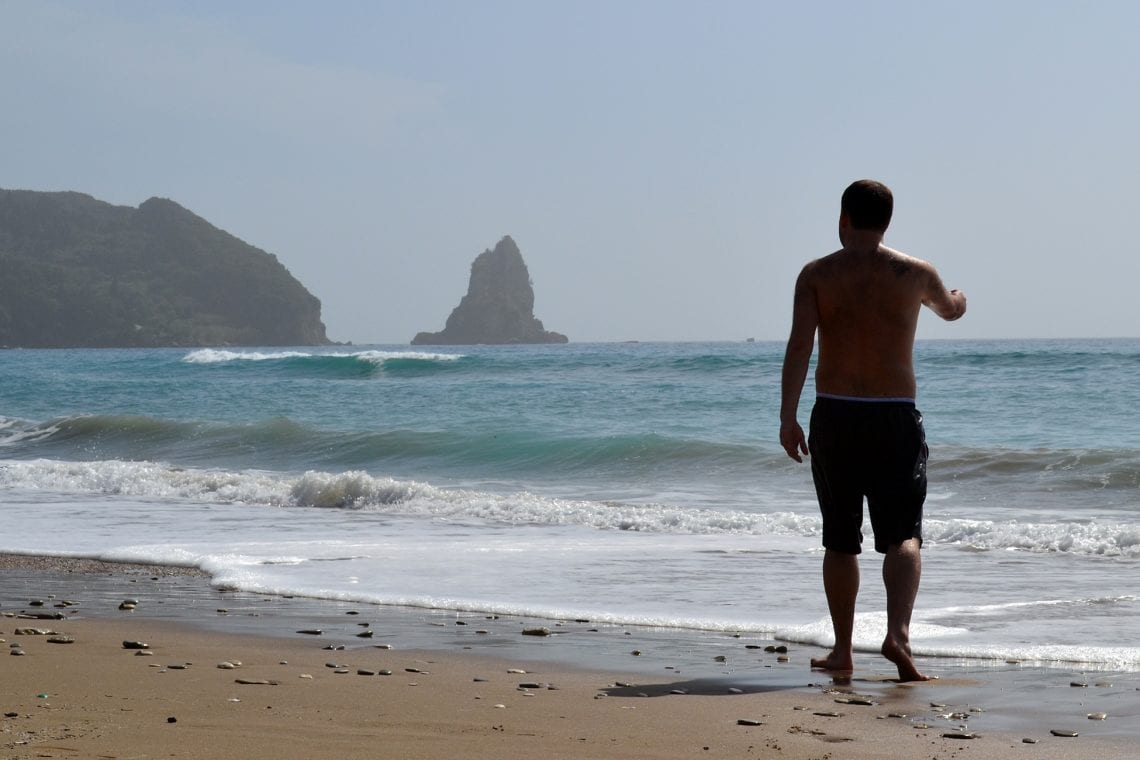
Above: The hydrofoil connects Albania to Corfu | Last day of our adventure before we fly home so a dip in the sea is defiantly called for
WHERE TO STAY
We stayed at the following:
- Zadar – Boutique Hostel Forum
- Mostar – Hostel Nina
- Sarajevo – Hostel Mills
- Dubrovink – OId Town Hostel
- Budva – Montenegro Hostel
- Tirana – Backpacker Hostel
- Orchid – Sunny Lake Hostel
- Saranda – Hairy Lemon Hostel
USEFUL LINKS
- Mtours offers great tours around Montenegro and beyond
- If you’re interested in a shorter trip through the Balkans check out our story on backpacking between Belgrade and Podgorica.



